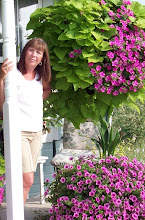


(pictured from left to right: orange cosmos, thunbergia, zinna)
The seed kiosks are popping up rampantly in all the usual places and although we are to have up to 2 inches of snow on Saturday morning, by Wednesday of next week, the temps are to be in the upper 60's again. Since the weather was so nice yesterday, my son, Nick, and I went on an outing which included stopping by a local nursery. Nick is as enthusiatic about gardening as I am so it was no wonder we found ourselves standing in front of a seed kiosk discussing the virtues of this year's selections. Earlier that morning, I'd received an email from a beginning gardener asking for a list of my favorite, easy-to-grow annuals. Needless to say, almost all the seed packets one finds at their local nursery are well suited for growing in one's own area. (Keep in mind that's not always the case with the big box or discount stores because they've no real choice over what seeds are sent to them.)
Giving it some real thought, I came up with a list of my favorite annuals. I've divided them into two categories: seed sown and already grown.
By seed sown, I mean annuals that are extremely quick to germinate in the flower bed and develop into nice plants early on in the season. These include:
cosmos
zinnia
marigolds
sunflowers
cox comb
thunbergia
moonflower
morning glory
hyacinth bean
alyssum
four o'clocks
bachelor buttons
All do well from sowing directly into the bed once the soil warms and stays above 50 degrees at night.
The second category, already grown, are the annuals I think do better if they are bought as seedlings and transplanted into your beds:
(picture from left to right: blackie sweet potato vine, raspberry blast supertunia, Victoria blue salvia)
Victoria blue salvia
supertunia
vinca
million bells
angelonia
snap dragons
dianthus
geraniums
ornamental sweet potato vine
Of the list above, the Victoria blue salvia can grow like a perennial in zone 5 if certain conditions are met. It must be planted on the south side of the house along the foundation where it is protected from the worst of our winters. For three years, mine have regenerated there whereas the same salvia planted in beds away from the protection of the house have perished.
I love how annuals add a constant splash of color to any flower bed. I purposely save room in all my perennial beds just so that I can add them into the mix each spring.








